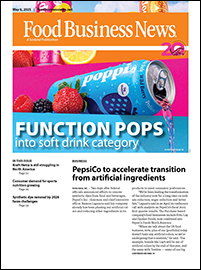
KANSAS CITY — Are consumers’ taste preferences evolving? Is less sweet in? Is the somewhat earthy taste of “brown” plant-based ingredients resonating with consumers, even in dairy products? Recent innovations suggest the answer to these questions is yes, with carefully selected fruit, nut and seed ingredients enabling their development.
For example, less than a month ago, The WhiteWave Foods Co., Denver, introduced a first-of-its-kind, no-sweetener-added fruit yogurt line called Wallaby Organic Purely Unsweetened Whole Milk Greek Yogurt. The fruit prep in one part of the dual-compartment container is made with fruit, locust bean gum and pectin, with some fruit and vegetable juices added for colors. There’s no added sweetener, resulting in a product that contains a mere 4 grams to 5 grams of sugar (from the fruit and milk’s inherent lactose) per 5.3-oz container. The company’s use of ripened fruit with balanced acid and sugar enables the fruit’s full flavor to be tasted without the need for sweetness enhancement.
Around the same time the Wallaby line was hitting refrigerated dairy cases, The Hain Celestial Group Inc., Lake Success, N.Y., began distributing The Greek Gods Nonfat Greek Yogurt with Chia Seeds. The not-too-sweet yogurt includes hydrated chia seeds, which add protein and fiber to the yogurt, while also adding texture and mouthfeel.
In Canada, JillyV’s Ltd. recently made its market debut with JillyV’s JumpStarter, which is a blend of organic yogurt, oats and chia topped with lightly sweetened fruit compote. An optional JumpPack makes the product line different than similar grain-style yogurts. Sold separately, a JumpPack includes toasted almonds, pecans, hemp hearts and ground flax and is intended to be added to the JumpStarter for an extra nutrition boost.

The three yogurt innovations, as well as many other recently introduced yogurt and dairy products, emphasize the plant-based food component of the total product. This is smart marketing, as plant-based foods are at the heart of the 2015-2020 Dietary Guidelines for Americans.
“Plant-based ingredients, combined with dairy foods, can help Americans improve their intake of essential nutrients,” said Jane Dummer, a registered dietitian, industry consultant and author of recently published The Need for Seeds. “They help to achieve the Dietary Guidelines’ recommendation for consuming a mostly plant-based diet, while also meeting the two to three servings of dairy recommendation.”
Fruits and nuts have long been added to all types of dairy products. Think pistachio pudding, Swiss almond cheese spread and butter pecan ice cream. Seeds, on the other hand, are a rather new inclusion.
“Seeds certainly aren’t a new ingredient. In fact quite the opposite is true,” Ms. Dummer said. “Ancient populations understood the power of seeds and as a result showcased foods containing seeds as a big part of their everyday lives and celebrations. While the health benefits are an obvious driver for the growing popularity of seeds today, their crunchy textures and earthy flavors are clearly appealing to consumers.”
Both consumers and food companies have taken note of the nutritional and sensory attributes of seeds. Hence, it’s increasingly common to see everything from breakfast cereal to meat marinade flagging the inclusion of some type of seed.
“People are looking for products beyond the ordinary. There is an excellent opportunity for the dairy industry to present something new as a line extension, to broaden their product offerings,” Ms. Dummer said.
For example, Minneapolis-based General Mills, Inc. has introduced Liberte & Seeds Greek Yogurt, which carries the descriptor “Greek yogurt is now crunchy: Uncover a wholesome combination of flax, pumpkin and sunflower seeds, in perfect harmony with fruit.”
“There’s no pullback in consumer desire for healthier products,” Ms. Dummer said. “Consumers want more convenient nutrient-dense snack options for their on-the-go lifestyle. Seeds pack a punch of plant protein, fiber, vitamins, minerals and essential fatty acids. For consumers who require nut-free or gluten-free, seeds are outstanding ingredient choices.”
In Ms. Dummer’s book, she profiles the seven most common seed ingredients: chia, flax, hemp, quinoa, pumpkin, sesame and sunflower.
“The reason I chose them is because of their outstanding health benefits, from decreasing inflammation to promoting digestive health,” she said. “Cultured dairy products, such as yogurt, have similar health benefits, which makes this a winning combination for consumers wanting an everyday nutritious choice that is interesting and delicious.”
Fruitful applications
Tom Leahy, spokesperson for Sunsweet Ingredients, Walnut Creek, Calif., agreed that plant-based ingredients make sense as inclusions in dairy foods, in particular yogurt.
“Adding nuts and seeds to any dairy product will enhance the product’s healthful image,” he said. “Moreover, nuts and seeds taste wonderful in dairy products. For example, the flavor and texture of soft cheeses with walnuts is hard to beat.

“Fruit adds brightness, antioxidants, sweetness and fiber. In the case of prunes, the sweet caramelized flavor of prunes melds perfectly with the tanginess of yogurt. This combination has long been valued by Europeans. In fact, in Europe, prune yogurt is considered a core flavor, just as strawberry or blueberry is here.”
A leading driver of yogurt consumption is digestive health.
“Prunes fit perfectly into this picture,” Mr. Leahy said. “Most consumers already know that prunes are good for digestive health. In some markets, such as Japan and Thailand, we are seeing increasing offerings of drinkable yogurts with prune.”
Prune is one of those fruits that consumers don’t expect to be too sweet. It may be added to dairy products, with little or no added sweetener, allowing its natural sweetness to satisfy.
“We have successfully used fresh plum concentrate to add sweetness to fruit preps,” Mr. Leahy said. “The flavor profile of plums can also mask the off-flavor of stevia, while contributing natural sweetness.”
Fig, another fruit gaining momentum in the yogurt category, often is combined with honey and intended to complement the Mediterranean inspiration behind Greek yogurt. For example, The Greek Gods brand offers a whole milk Fig Honey Greek-Style Yogurt containing a puree made of fig concentrate and fig paste.
“Food formulators are constantly searching for versatile ingredients that taste great, add nutritional value and appeal to a variety of consumers,” said chef John Csukor of Kor Food Innovation, Ashland, Va. “Loaded with fiber, calcium, potassium, iron and antioxidants, this ancient fruit complements the trend towards better-for-you, clean eating. Figs are also low on the glycemic index, making them a healthy and diabetic-friendly way to add a touch of sweetness to your products.”
Karla Stockli, chief executive officer of the California Fig Advisory Board, Fresno, Calif., said fig juice concentrate naturally colors foods in varying shades of brown, depending on fig variety or blend of fig varieties. For example, fig powder or paste may be used to add color to chocolate-flavored dairy products, including ice cream, smoothies and even yogurt.
Quebec-based Laiterie Chalifoux is embracing fig and other “luxurious” ingredients, as the company refers to them, in a new line of indulgent, yet nutritious products sold under the Riviera brand Petit Pot banner. Sold in glass pots to showcase the quality ingredients, Petit Pot organic 2% milkfat yogurt comes in four European-inspired flavors. In addition to fig, there’s apricot, rhubarb and nuts, with the latter, being a mixed nut paste-like variegate.
Bananas fall into the brown flavor family as well. Though yellow at the beginning, when they are fully to over- ripened, they go brown, and that is the banana flavor most consumers recognize in recipes.
Allen Ballerini, corporate chef for Carolina Innovative Food Ingredients, Nashville, N.C., recently developed a better-for-you bananas Foster variegate that combines sweet potato ingredients with banana puree. It may be used with Greek yogurt to make a healthful parfait.
“The non-acidified sweet potato juice concentrate has molasses flavor notes that complement banana,” he said. “Add a little vanilla extract and maple flavor, and this no-sugar-added variegate tastes similar to the New Orleans-famed dessert, without all the calories and now with vitamins, minerals and fiber.”
Flavors and nuts
Bill Aslanides, senior flavor chemist, Synergy Flavors Inc., Wauconda, Ill., explained how flavors may assist with developing sweetness perception without contributing calories.
“We can use compounded flavors to improve the perceived sweetness of applications with low sweetener levels,” he said. “Certain flavoring materials exist, and are available to flavorists, that work in coordination with the naturally occurring sugars of the application itself to mimic an overall increased sweetness level. The use of flavors can also contribute to the overall fruitiness profile of fruit preparations used dairy applications. This enhanced sensory profile can be perceived as increased sweetness and may also add mouthfeel to what may have been perceived as a ‘thin’ tasting product.”
When it comes to adding nuts to dairy applications, a growing trend involves including them in toppings for yogurt or mixing them into ice cream. Even spreadable cheeses are getting some crunch.

“Consumers love the nutritional and sensory appeal of almonds, and their subtle taste complements any yogurt flavor,” said Jeff Smith, director of marketing, Blue Diamond Almonds Global Ingredients Division, Sacramento, Calif. “We know consumers are very familiar with the heart-healthy and nutritional profile of almonds, which have the most protein of any tree nut. Almonds also contribute fiber and healthy monounsaturated fats.
“Because almonds come in a wide range of forms — split, sliced, slivered, diced, flakes and more — they can provide texture within dairy products like yogurt or ice cream. Unlike other inclusions that may become soggy in yogurt and ice cream, almonds hold this crunch and complement the taste without overpowering the desired creamy texture.”
“Whether paired with fruit or simply added to dairy products as a topping or inclusion, almonds can be used in a variety of ways to meet consumer demand and remain on-trend with the desire for clean, simple and better-for-you,” said Harbinder Maan, senior marketing manager, Almond Board of California, Modesto, Calif.
Almonds possess the unique ability to carry flavor. The R.&D. team at the Blue Diamond Almond Innovation Center is creating new flavor profiles for almonds and working with manufacturers to help them create products that appeal to consumers’ increasingly sophisticated palates.
“They are working with sweet flavors such as orange, honey and coconut that would complement many yogurt and ice cream products,” Mr. Smith said.
In conclusion, Jeff Manning, chief marketing officer, Cherry Marketing Institute, Dewitt, Mich., sums up the flavor changes taking place in the dairy products industry: “Self-denial is taking backstage as health and indulgence increasingly coexist in the mind of the consumer,” he said. “Brands are reimagining product innovations that pair a bit of indulgence with natural ingredients that offer a nutrition halo.”




